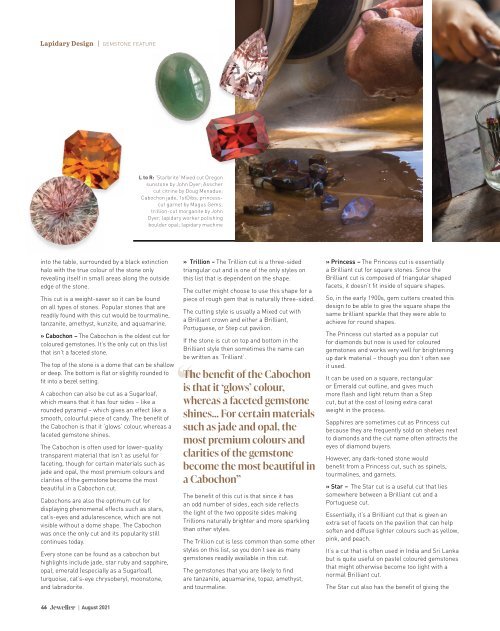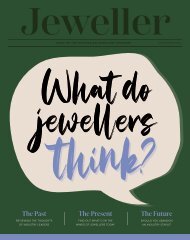You also want an ePaper? Increase the reach of your titles
YUMPU automatically turns print PDFs into web optimized ePapers that Google loves.
Lapidary Design | GEMSTONE FEATURE<br />
L to R: 'Starbrite' Mixed cut Oregon<br />
sunstone by John Dyer; Asscher<br />
cut citrine by Doug Menadue;<br />
Cabochon jade, 1stDibs; princesscut<br />
garnet by Magus Gems;<br />
trillion-cut morganite by John<br />
Dyer; lapidary worker polishing<br />
boulder opal; lapidary machine<br />
into the table, surrounded by a black extinction<br />
halo with the true colour of the stone only<br />
revealing itself in small areas along the outside<br />
edge of the stone.<br />
This cut is a weight-saver so it can be found<br />
on all types of stones. Popular stones that are<br />
readily found with this cut would be tourmaline,<br />
tanzanite, amethyst, kunzite, and aquamarine.<br />
» Cabochon – The Cabochon is the oldest cut for<br />
coloured gemstones. It’s the only cut on this list<br />
that isn’t a faceted stone.<br />
The top of the stone is a dome that can be shallow<br />
or deep. The bottom is flat or slightly rounded to<br />
fit into a bezel setting.<br />
A cabochon can also be cut as a Sugarloaf,<br />
which means that it has four sides – like a<br />
rounded pyramid – which gives an effect like a<br />
smooth, colourful piece of candy. The benefit of<br />
the Cabochon is that it ‘glows’ colour, whereas a<br />
faceted gemstone shines.<br />
The Cabochon is often used for lower-quality<br />
transparent material that isn’t as useful for<br />
faceting, though for certain materials such as<br />
jade and opal, the most premium colours and<br />
clarities of the gemstone become the most<br />
beautiful in a Cabochon cut.<br />
Cabochons are also the optimum cut for<br />
displaying phenomenal effects such as stars,<br />
cat’s-eyes and adularescence, which are not<br />
visible without a dome shape. The Cabochon<br />
was once the only cut and its popularity still<br />
continues today.<br />
Every stone can be found as a cabochon but<br />
highlights include jade, star ruby and sapphire,<br />
opal, emerald (especially as a Sugarloaf),<br />
turquoise, cat’s-eye chrysoberyl, moonstone,<br />
and labradorite.<br />
» Trillion – The Trillion cut is a three-sided<br />
triangular cut and is one of the only styles on<br />
this list that is dependent on the shape.<br />
The cutter might choose to use this shape for a<br />
piece of rough gem that is naturally three-sided.<br />
The cutting style is usually a Mixed cut with<br />
a Brilliant crown and either a Brilliant,<br />
Portuguese, or Step cut pavilion.<br />
If the stone is cut on top and bottom in the<br />
Brilliant style then sometimes the name can<br />
be written as ‘Trilliant’.<br />
The benefit of the Cabochon<br />
is that it ‘glows’ colour,<br />
whereas a faceted gemstone<br />
shines... For certain materials<br />
such as jade and opal, the<br />
most premium colours and<br />
clarities of the gemstone<br />
become the most beautiful in<br />
a Cabochon”<br />
The benefit of this cut is that since it has<br />
an odd number of sides, each side reflects<br />
the light of the two opposite sides making<br />
Trillions naturally brighter and more sparkling<br />
than other styles.<br />
The Trillion cut is less common than some other<br />
styles on this list, so you don’t see as many<br />
gemstones readily available in this cut.<br />
The gemstones that you are likely to find<br />
are tanzanite, aquamarine, topaz, amethyst,<br />
and tourmaline.<br />
» Princess – The Princess cut is essentially<br />
a Brilliant cut for square stones. Since the<br />
Brilliant cut is composed of triangular shaped<br />
facets, it doesn’t fit inside of square shapes.<br />
So, in the early 1900s, gem cutters created this<br />
design to be able to give the square shape the<br />
same brilliant sparkle that they were able to<br />
achieve for round shapes.<br />
The Princess cut started as a popular cut<br />
for diamonds but now is used for coloured<br />
gemstones and works very well for brightening<br />
up dark material – though you don’t often see<br />
it used.<br />
It can be used on a square, rectangular<br />
or Emerald cut outline, and gives much<br />
more flash and light return than a Step<br />
cut, but at the cost of losing extra carat<br />
weight in the process.<br />
Sapphires are sometimes cut as Princess cut<br />
because they are frequently sold on shelves next<br />
to diamonds and the cut name often attracts the<br />
eyes of diamond buyers.<br />
However, any dark-toned stone would<br />
benefit from a Princess cut, such as spinels,<br />
tourmalines, and garnets.<br />
» Star – The Star cut is a useful cut that lies<br />
somewhere between a Brilliant cut and a<br />
Portuguese cut.<br />
Essentially, it’s a Brilliant cut that is given an<br />
extra set of facets on the pavilion that can help<br />
soften and diffuse lighter colours such as yellow,<br />
pink, and peach.<br />
It’s a cut that is often used in India and Sri Lanka<br />
but is quite useful on pastel coloured gemstones<br />
that might otherwise become too light with a<br />
normal Brilliant cut.<br />
The Star cut also has the benefit of giving the<br />
46 | <strong>August</strong> <strong>2021</strong>


















